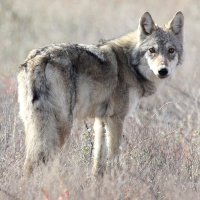 |
Steppe wolf |
|
He is a wild animal |
Origin |
Russia | |
Translation |
Francis Vandersteen |
| The possession of this animal is not authorized Royal Decree establishing the list of mammals not kept for production purposes that may be kept (M.B. 24.08.2009) |
| The steppe wolf was classified as a subspecies of the gray wolf Canis lupus campestris in 1804 by Russian scientist Ivan Dwigubski. It is also known as the Caspian wolf and the Caucasian wolf. Most taxonomists recognize Canis lupus campestris, Canis lupus bactrianus, Canis lupus cubanensis and Canis lupus desertorum as a single subspecies. The steppe wolf is generally confused with Canis lupus chanco, which is the Tibetan or Mongolian wolf. The historical range of the steppe wolf is in the countries surrounding the Caspian and Black Seas. Today, it exists only in a remote area of extreme south-west Russia bordering the northern half of the Caspian Sea. Steppe wolves generally come in desert colors to blend in with their surroundings. They are not white like many northern Siberian wolves. Caspian wolves generally weigh up to 40 kg, with short coats that show shades of gray with rust or brown and black hairs on the back with a poorly furred tail. They will eat almost any animal they can catch. Wolves usually hunt in packs, but the steppe wolf hunts alone when food (especially large prey) is scarce. Steppe wolves usually feed on herd animals, rodents and fish. When food is scarce, they may also eat berries and other fruits. Although they usually eat almost any animal they can catch, packs and lone steppe wolves have been known to kill more than they are able to feed on, particularly Caspian seals. They are also likely to hunt the domestic animals of nomadic families at any time of the day or night. They hunt when they're hungry, but if they're not successful, they can go without food for several weeks. Like most other wolves, mating is usually between the pack's dominant pair. Breeding generally takes place between January and April. After around 63 days, the mother will give birth to 4 to 7 pups, usually raised by the whole pack. The Canis lupus campestris has been hunted as a nuisance for many years. It is on the Red List of Mongolian Mamals (2007) and can now only be found in the extreme south-western part of Russia, along the Caspian Sea. |






 English (United Kingdom)
English (United Kingdom)